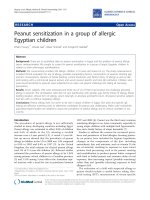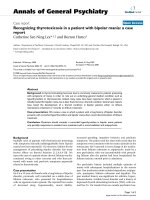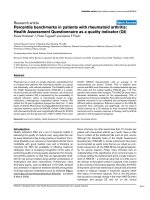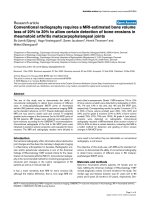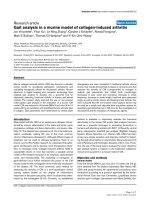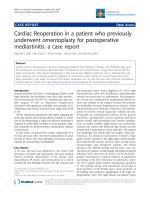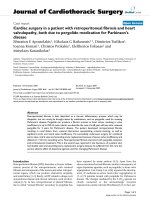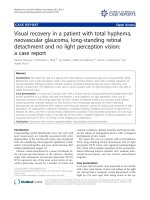Báo cáo y học: "Interfacility transfers in a non-trauma system setting: an assessment of the Greek reality" pdf
Bạn đang xem bản rút gọn của tài liệu. Xem và tải ngay bản đầy đủ của tài liệu tại đây (491.39 KB, 7 trang )
Katsaragakis et al. Scandinavian Journal of Trauma, Resuscitation and Emergency Medi-
cine 2010, 18:14
Open Access
ORIGINAL RESEARCH
© 2010 Katsaragakis et al; licensee BioMed Central Ltd. This is an Open Access article distributed under the terms of the Creative Com-
mons Attribution License ( which permits unrestricted use, distribution, and reproduc-
tion in any medium, provided the original work is properly cited.
Original research
Interfacility transfers in a non-trauma system
setting: an assessment of the Greek reality
Stylianos Katsaragakis
1
, Panagiotis G Drimousis*
1
, Eleftheria S Kleidi
1
, Kostas Toutouzas
1
, Eleftherios Lapidakis
2
,
Georgios Papadakis
3
, Kritolaos Daskalakis
4
, Andreas Larentzakis
1
, Maria E Theodoraki
5
and Dimitrios Theodorou
1
Abstract
Background: Quality assessment of any trauma system involves the evaluation of the transferring patterns. This study
aims to assess interfacility transfers in the absence of a formal trauma system setting and to estimate the benefits from
implementing a more organized structure.
Methods: The 'Report of the Epidemiology and Management of Trauma in Greece' is a one year project of trauma
patient reporting throughout the country. It provided data concerning the patterns of interfacility transfers. We
compared the transferred patient group to the non transferred patient group. Information reviewed included patient
and injury characteristics, need for an operation, Intensive Care Unit (ICU) admittance and mortality. Analysis employed
descriptive statistics and Chi-square test. Interfacility transfers were then assessed according to each health care
facility's availability of five requirements; Computed Tomography scanner, ICU, neurosurgeon, orthopedic and vascular
surgeon.
Results: Data on 8,524 patients were analyzed; 86.3% were treated at the same facility, whereas 13.7% were transferred.
Transferred patients tended to be younger, male, and more severely injured than non transferred patients. Moreover,
they were admitted to ICU more often, had a higher mortality rate but were less operated on compared to non
transferred patients. The 34.3% of transfers was from facilities with none of the five requirements, whereas the 12.4%
was from those with one requirement. Low level facilities, with up to three requirements transferred 43.2% of their
transfer volume to units of equal resources.
Conclusion: Trauma management in Greece results in a high number of transfers. Patients are frequently transferred
between low level facilities. Better coordination could lead to improved outcomes and less cost.
Background
The goal of a trauma system is to consistently get the
right patient to the right type of hospital in the right
amount of time. This requires an organized and coordi-
nated process [1]. Trauma systems are designed to cen-
tralize resources and experience, to assure appropriate
access to definite care and to maximize efficiency [2,3].
Although trauma systems have reduced trauma mortality
in the USA [4-7], most European countries including
Greece do not have formal systems.
Interfacility transfers are resource intensive, particu-
larly in rural regions where patients may require trans-
port over hundreds of miles, and transport time may
delay definite treatment [8]. Transfers from rural to urban
areas are often required for specialist expertise and/or
more sophisticated treatment options [9]. Quality assess-
ment for any established or proposed trauma system
requires the evaluation of transport patterns.
The National Health System in Greece is government
funded and has three levels of health care facilities. Pri-
mary health care units are general practitioner based out-
patient facilities. They are mostly implemented in remote
areas to address the need for emergency care. Secondary
health care units are general hospitals. In most cases,
these structures are situated in the capital of each of the
50 prefectures. There is considerable diversity among
these facilities. Those that are situated in major cities may
be quite sophisticated whereas those in remote, rural pre-
fectures usually have limited resources and personnel.
* Correspondence:
1
First Department of Propaedeutic Surgery, Surgical Intensive Care Unit,
Hippocration General Hospital, Athens, Greece
Katsaragakis et al. Scandinavian Journal of Trauma, Resuscitation and Emer-
gency Medicine 2010, 18:14
Page 2 of 7
The third degree of health care (tertiary units) consists of
specialized centers and university hospitals which are pri-
marily in major cities. Secondary health care units may
function like a Level II, III or IV trauma center, whereas a
tertiary unit has capabilities similar to a Level I or II
trauma center. Emergency incidents in our country are
referred to the regional primary or secondary health care
facility and if further resources are needed, patients are
transferred to a higher level center. There are some pri-
vate hospitals but these are mostly located in major cities.
In many ways, Greece is highly urbanized and more
than 40% of the population lives in the two major cities.
However, there are hundreds of habitable islands many
with limited access to the mainland.
The National Emergency Center is the only official car-
rier responsible for patient transportation in Greece.
Transfers from islands are performed by ground, air or
water. Transfer means personnel are mostly paramedics
with varying degrees of emergency care training. There is
a coordinating authority in the National Emergency Cen-
ter but it has radio access only to the ambulances and not
to the receiving hospital.
The purpose of the present study is to assess interfacil-
ity transfers in a country with discrete needs of transpor-
tation and no official trauma system implementation. For
this reason data out of a countrywide registry are pre-
sented and initially analyzed.
Methods
Study Design and Population
The 'Report of the Epidemiology and Management of
Trauma in Greece' is a project initiated by the Hellenic
Society of Trauma and Emergency Surgery in October
2005. It represents an effort to register and evaluate the
epidemiology of trauma in Greece and to critically assess
the management of trauma patients in the country. The
project comprises prospectively collected data on trauma
patients from October 2005 till October 2006.
There are 99 hospitals in Greece but only 80 accept
trauma patients. All facilities with surgeons who served
as official representatives of the Society were invited to
participate in the registry. Thirty two representatives
responded positively accounting for 40% of hospitals
accepting trauma patients. The participating hospitals
provide trauma care for approximately 40% of the coun-
try's residents.
All reporting data forms were completed prospectively
by the official representative surgeons and mailed to the
Board of the Society on a monthly basis. A physician
transferred the data to an electronic database for future
statistical evaluation. The database was subsequently
cross checked for double entries (patients who had been
reported by both sending and receiving hospitals) and
accuracy by an independent physician. Reports with
more than 5% missing data were excluded from the data-
base. Inclusion criteria for the registry were defined as
either trauma patients that required admission, or trans-
fer to another unit or arrived dead or died in the Emer-
gency Department. International recommendations for
uniform reporting of data following trauma were fol-
lowed [10,11].
Setting and data collection
Specific fields in the reporting data form noted whether
the trauma patient was transferred in from another
health care unit, or transferred out to another hospital.
Transferred patients were defined as those patients that
arrived at the reporting hospital after being initially eval-
uated or managed in another health care unit or trans-
ported from the reporting unit to another hospital. Non
transferred patients were defined as those patients who
were definitely treated at the reporting hospital. Injured
military personnel and trauma patients with a private
health care insurance who requested a transfer to a pri-
vate hospital were excluded from the analysis. Legislation
in Greece requires that all military personnel are trans-
ferred to a military hospital after initial evaluation and
care irrespective of the medical indications. Database
trauma patients that arrived dead directly from the scene
of injury or died in the Emergency Department were also
excluded from this analysis. The transferred group was
then compared to the non transferred group and the vari-
ables reviewed included gender, age, Injury Severity Score
(ISS), mechanism and cause of injury, need for an opera-
tion, need for ICU admittance and mortality.
Additional data collection
In order to accurately evaluate the actual resources of
each facility the data collection form specifically inquired
for the availability of an Intensive Care Unit (ICU) and of
a Computed Tomography (CT) scanner on a 24 hour
basis, and for the presence of a neurosurgeon, an ortho-
pedic surgeon and a vascular surgeon in both the Emer-
gency Department and the hospital. For each of these
prerequisites a point was given to each facility. A score of
five out of five (5/5) implies that the facility's infrastruc-
ture satisfied all five requirements, whereas a score of
zero out of five (0/5) suggests that the facility did not have
any of the above. Furthermore, facilities were divided into
two levels; "low level" facilities met up to three require-
ments, whereas "high level" facilities had four or five
requirements.
The official representatives were asked to provide addi-
tional information for each institution, concerning the
availability of resources and specific specialties in the
receiving and the referring facility.
Katsaragakis et al. Scandinavian Journal of Trauma, Resuscitation and Emer-
gency Medicine 2010, 18:14
Page 3 of 7
Ethics
This sub-study was reviewed and approved by the Hel-
lenic Society of Trauma and Emergency Surgery. The
Society is a non governmental entity, authorized under
Greek law to design, approve and finance observational
studies in relevant scientific fields.
Data Analysis
Statistical analyses were performed using chi square test
for comparison of data. Pearson chi square test was used
for parametric variables and Mann-Whitney test for non-
parametric ones. Data are represented as mean ± SD
(standard deviation), unless otherwise specified.
Results
After excluding the 11 soldiers, 60 private insurance
patients and trauma patients who were dead on arrival,
data on 8,524 patients were included in the analysis. Of
them, 7,359 (86.3%) arrived directly from the scene and
were treated at the same facility, whereas 1,165 (13.7%)
were transferred. Of the 1,165 total transfers, 536 (46%)
were transferred in to the reporting hospital, 569 (48.8%)
were transferred from the reporting hospital to another
facility and 60 patients (5.2%) were double transferred; i.e.
transferred from health care unit A to B and from B to C,
where B is the reporting hospital in the registry. Table 1
shows these data for the total number of transfers
reported in this study.
Figure 1 shows the seasonal distribution of transfers.
There is a substantial increase in transfers during sum-
mer and a respective fall during winter.
Table 2 shows the differences in patient and injury
characteristics between transferred and non transferred
patients. In transferred group there were more male, the
mean age was lower than that of the non transferred
group and the injury severity score was higher. As for the
mechanism of injury that led to a transfer, 27.5% of
burned patients were transferred, followed by blunt
(13.6%) and penetrating trauma (11.6%). Regarding the
cause of injury, 16.9% of patients with industrial injuries
were transferred and concomitantly were motor vehicle
collisions (16.4%) and falls (10.9%).
Table 3 shows the frequency of operation and ICU
admission, as well as the mortality rates in each group.
Transferred patients were less likely to be operated on
(19.9% versus 30%) but were admitted to ICU in a higher
percentage (2.7% versus 1.3% respectively). Moreover,
3.5% of the transferred patients died, whereas the mortal-
ity of non transferred patients was 2%.
The comparison of transferred and non transferred
patients' ISS is shown in Figure 2. The most severely
injured patients (ISS >24) were transferred more often
(34.7%), whereas 11.2% of patients with minor injuries
(ISS 1-9) were transferred.
Table 4 groups the health care facilities in two catego-
ries: low level facilities that met up to three requirements
and high level facilities that met four or more require-
ments (ICU, CT scanner, neurosurgeon, orthopedic sur-
Table 1: Distribution of transfers in the total number of patients
PATIENTS N % of TP* % of TRP*
Transferred From another unit 536 6.3 46.0
To another unit 569 6.7 48.8
From and to another
unit
60 0.7 5.2
Total transferred 1165 13.7 100
Non Transferred Total non transferred 7359 86.3
TOTAL Total patients 8524 100
* TP, Total Patients; TRP, Transferred Patients
Figure 1 Seasonal distribution of interfacility transfers.
Katsaragakis et al. Scandinavian Journal of Trauma, Resuscitation and Emer-
gency Medicine 2010, 18:14
Page 4 of 7
geon and vascular surgeon). Low level facilities
transferred 43.2% of those patients that they did transfer
to other low level facilities and only 55.4% to a higher
level unit. Moreover, 18.4% of the transferred patients
went from a high level facility to a lower level facility.
Discussion
Interfacility transfers are an integral part of any health
care system particularly one focused on trauma care.
Coordinated trauma care requires that an infrastructure
exists for the transfer of injured patients [12]. There are
numerous prerequisites for optimal outcome: a central
coordinating authority, a well equipped ambulatory ser-
vice, radio-communication between the ambulances and
Table 2: Differences in patient and injury characteristics between Transferred and Non Transferred patients
CHARACTERISTIC NON TRANSFERRED TRANSFERRED
Gender, N (%) Female 2409 (89.2) 291 (10.8)
Male 4950 (85.0) 874 (15.0)
Age (y) (mean ± SD) 45.8 ± 22.2 40.6 ± 23.4
I.S.S (median ± IQR)* 4.0 ± 5.0 9.0 ± 9.0
Mechanism of injury Burn 108 (72.5) 41 (27.5)
N (%) Blunt 6459 (86.4) 1015 (13.6)
Penetrating 374 (88.4) 49 (11.6)
Unknown 418 (87.4) 60 (12.6)
Cause of injury Industrial 452 (83.1) 92 (16.9)
N (%) MVC** 3028 (83.6) 596 (16.4)
Fall 2500 (89.1) 306 (10.9)
Illegal act 432 (91.9) 38 (8.1)
Sports 130 (94.2) 8 (5.8)
Other 233 (82.6) 49 (17.4)
Unknown 584 (88.5) 76 (11.5)
* Inter quartile range
** MVC, Motor Vehicle Collision
Table 3: Frequency of operation, ICU* admission and mortality rates in Transferred and Non Transferred patients
NON TRANSFERRED TRANSFERRED
Operation, N (%) No 5153 70.0% 933 80.1%
Yes 2206 30.0% 232 19.9%
ICU admission, N
(%)
No 7265 98.7% 1134 97.3%
Yes 941.3% 312.7%
Dead, N (%) No 7211 98.0% 1124 96.5%
Yes 148 2.0% 41 3.5%
* ICU, Intensive Care Unit
Katsaragakis et al. Scandinavian Journal of Trauma, Resuscitation and Emer-
gency Medicine 2010, 18:14
Page 5 of 7
the receiving hospital, predefined arrangements between
hospitals in the same geographical area, adequately
trained paramedics and strict protocols of action are only
few of these [13]. Optimally, trauma patients should go
directly from the scene to the right hospital for the injury
they sustained. This is not always the nearest facility.
Even when the closest facility is appropriate for initial sta-
bilization subsequent transfers should be made as quickly
and efficiently as possible. This process is expedited by a
systems approach [14,15].
Quality assessment of any trauma system involves the
evaluation of the transferring patterns [16]. The geo-
graphic diversity and population distribution of Greece
renders this evaluation quite challenging. This is made
worse by the lack of predefined agreements between
institutions; accepted transporting guidelines and the fact
that responsibility for transfers belongs to the referring
physician and to the National Emergency Center, which
typically has limited access to vital information.
The overall transfer rate observed (13.7%) is one of the
highest rates reported in studies with similar inclusion
criteria [8,15,16]. In our opinion, the main reason for this
is that the patients are transferred to the closest rather
than to the most suitable institution. Moreover, the pre-
fecture-based infrastructure of the health care system
produces a misleading situation; all prefectures have at
least one 'secondary' hospital that receives all trauma
patients in the prefecture, but all hospitals designated as
'secondary' are not the same. In realistic terms, trauma
patients may be transferred from the scene to a facility
that is totally unsuitable for their injury, and therefore the
necessity for further management will remain, leading to
increased transfer rates.
A number of recent studies have reported several rea-
sons for patient transfer. These include gender, age, race,
specialist availability and referring facility's characteris-
tics [1-3,17,18]. In our study, transferred patients tended
to be younger and male. Transfer rates are relatively high
during summer when the majority of the population trav-
els for vacations and when millions of tourists arrive in
the country, mostly in the islands where the health care
resources are relatively poor.
Injury severity plays an important role in the decision
making of a transfer [19]. Transferred patients did have a
higher median Injury Severity Score than non transferred
ones but most patients had relatively minor injuries
(median ISS 9.0 and 4.0 respectively). In addition, transfer
rates increased proportionately to ISS categories imply-
ing a proper manner of interfacility transfer. However,
fifty percent of transferred patients had an ISS lower than
10 which implies over triage or primary referral to an
inappropriate center. The latter may be reflected by the
Figure 2 Comparison of transferred and non transferred patients
regarding Injury Severity Score.
Table 4: Distribution of transfers according to the level of the referring and the receiving facility.
RECEIVING FACILITY
Lowa
(%)
Highb
(%)
Unkc
(%) Total
REFERRI
NG
FACILITY
Lowa
397 (43.2) 510 (55.4) 13 (1.4) 920
Highb
34 (18.4) 137 (74.1) 14 (7.6) 185
TOTAL 431 647 27 1105
d
a
Low level: up to three out of five requirements (Computed Tomography scanner, Intensive Care Unit, neurosurgeon, orthopedic and
vascular surgeon)
b
High level: four or more out of five requirements
c
Unk, Unknown
d
Total transfers after excluding double-transferred patients
Katsaragakis et al. Scandinavian Journal of Trauma, Resuscitation and Emer-
gency Medicine 2010, 18:14
Page 6 of 7
fact that referring units with no requirements -as defined
in our study- transferred 34.3% of the total transferred
patients, whereas units with at least one transferred only
12.4%. Community health centers do serve as a local
resource to care for minor injuries, which helps to reduce
the burden on the more specialized units and avoid
unnecessary transport over long distances but they are
incapable of treating more serious injuries. In our geo-
graphical setting, where transfer over sea distances can be
complex and expensive coordination between primary
and specialized centers is essential.
Unlike other studies [1,3,6,17,20], we found that burns
were overrepresented among transferred patients. This
can be attributed to the fact that there are three centers
specialized in treating burn injuries in the whole country
and they are situated in the two major cities. Even though
the total number of patients transferred for this reason is
relatively low, it may still indicate the need of a more
extensive distribution of specialized centers throughout
the country.
The fact that 43.2% of the transfers from hospitals with
3 or fewer resources actually go to a hospital of the same
level implies that the stated resources (ICU beds, CT
scanners or operating rooms) may not always be avail-
able, Interestingly enough, hospitals with just one out of
five requirements (in most cases it is the presence of a CT
scanner) are responsible for the 12.4% of the total transfer
volume, whereas facilities with 2/5 requirements are
responsible for the 17.4% of the total number of transfers.
On the other hand, the fact that 34.3% of all transfers are
from units with no requirements at all implies that the
presence of a single requirement may result in a substan-
tial decrease in the frequency of transfers. This indicates
the demand of a more organized distribution of
resources.
Limitations
One of the major drawbacks of this study is that in most
cases only one of the facilities involved participated in the
registry. Personal communication of the official represen-
tatives with the receiving hospitals added some missing
data. These mainly involved patient additional injuries
and outcome but still there are missing points. There is
also data missing about the initial evaluation and man-
agement when only the receiving facility reported.
Conclusions
Our results show that the current system of trauma man-
agement in Greece has a high number of transfers and
that patients are frequently transferred between two facil-
ities with low resources. A more coordinated system
would be more efficient. This would likely result in better
outcomes. Since the Greek health care system is publi-
cally funded, reducing the number of transfers would
probably reduce overall costs as well. This research group
from the Hellenic Society of Trauma and Emergency Sur-
gery will assess these changes as they occur.
List of Abbreviations
CT: Computed Tomography; ICU: Intensive Care Unit;
ISS: Injury Severity Score; SD: Standard Deviation.
Competing interests
The authors declare that they have no competing interests.
Authors' contributions
SK conceived the study, undertook recruitment of participating centers and
chaired the data oversight committee. PGD analyzed the data and critically
revised the manuscript. KT designed the trial and was responsible for the qual-
ity control of the study. EL undertook recruitment of participating patients and
supervised the data collection. KD undertook recruitment of participating
patients and supervised the data collection. AL transferred the data in elec-
tronic form and drafted the manuscript. GP undertook recruitment of partici-
pating patients and supervised the data collection. MET provided statistical
advice on study design, analyzed the data and was responsible for the quality
control of the study. ESK transferred the data in electronic form, analyzed the
data and drafted the manuscript. DT designed the trial, supervised the conduct
of the trial and critically revised the manuscript. All authors approved the final
version.
Author Details
1
First Department of Propaedeutic Surgery, Surgical Intensive Care Unit,
Hippocration General Hospital, Athens, Greece,
2
First Surgical Department,
General Hospital KAT, Athens, Greece,
3
Second Surgical Department, General
Hospital KAT, Athens, Greece,
4
Surgical Department, General Hospital of
Rethymno, Rethymno, Greece and
5
Biostatistician, First Propaedeutic Surgical
Clinic, Hippocration General Hospital, Athens Medical School, Greece
References
1. Esposito TJ, Crandall M, Reed RL, Gamelli RL, Luchette FA: Socioeconomic
factors, medicolegal issues, and trauma patient transfer trends: Is there
a connection? J Trauma 2006, 61(6):1380-6.
2. Ciesla DJ, Sava JA, Street JH, Jordan MH: Secondary overtriage: a
consequence of an immature trauma system. J Am Coll Surg 2008,
206(1):131-7.
3. Koval KJ, Tingey CW, Spratt KF: Are patients being transferred to level-I
trauma centers for reasons other than medical necessity? J Bone Joint
Surg Am 2006, 88(10):2124-32.
4. Tinkoff GH, O'Connor RE, Alexander EL, Jones MS: The Delaware trauma
system: impact of Level III trauma centers. J Trauma 2007, 63(1):121-6.
5. Helling TS: Trauma care at rural level III trauma centers in a state trauma
system. J Trauma 2007, 62(2):498-503.
6. Barringer ML, Thomason MH, Kilgo P, Spallone L: Improving outcomes in
a regional trauma system: impact of a level III trauma center. Am J Surg
2006, 192(5):685-9.
7. Sampalis JS, Denis R, Lavoie A, Fréchette P, Boukas S, Nikolis A, Benoit D,
Fleiszer D, Brown R, Churchill-Smith M, Mulder D: Trauma care
regionalization: a process-outcome evaluation. J Trauma 1999,
46(4):565-79.
8. Newgard CD, McConnell KJ, Hedges JR, Mullins RJ: The benefit of higher
level of care transfer of injured patients from nontertiary hospital
emergency departments. J Trauma 2007, 63(5):965-71.
9. Wong K, Levy RD: Interhospital transfers of patients with surgical
emergencies: areas for improvement. Aust J Rural Health 2005,
13(5):290-4.
10. Champion HR, Copes WS, Sacco WJ: The major trauma outcome study:
establishing national forms for trauma care. J Trauma 1990,
30:1356-1365.
11. Dick WF, Baskett PJ: Recommendations for uniform reporting of data
following major trauma: the Utstein style. A report of a working party
Received: 24 October 2009 Accepted: 16 March 2010
Published: 16 March 2010
This article is available from: 2010 Katsaragakis et al; licensee BioMed Central Ltd. This is an Open Access article distributed under the terms of the Creative Commons Attribution License ( .0), which permits unrestricted use, distribution, and reproduction in any medium, provided the original work is properly cited.Scandinavi an Journal of Trau ma, Resuscita tion and Emergenc y Medicine 2010, 18:14
Katsaragakis et al. Scandinavian Journal of Trauma, Resuscitation and Emer-
gency Medicine 2010, 18:14
Page 7 of 7
of the International Trauma Anaesthesia and Critical Care Society
(ITACCS). Resuscitation 1999, 42:81-100.
12. Cooney JA: Inter-hospital transfers. Br J Anaesth 2005, 95(1):112-3.
13. Golestanian E, Scruggs JE, Gangnon RE, Mak RP, Wood KE: Effect of
interhospital transfer on resource utilization and outcomes at a tertiary
care referral center. Crit Care Med 2007, 35(6):1470-6.
14. Weinberg JA, McKinley K, Petersen SR, Demarest GB, Timberlake GA,
Gardner RS: Trauma laparotomy in a rural setting before transfer to a
regional center: does it save lives? J Trauma 2003, 54(5):823-6.
discussion 826-8
15. O'Connor RE: Specialty coverage at non-tertiary care centers. Prehosp
Emerg Care 2006, 10(3):343-6.
16. Sihler KC, Hansen AR, Torner JC, Kealey GP, Morgan LJ, Zwerling C:
Characteristics of twice-transferred, rural trauma patients. Prehosp
Emerg Care 2002, 6(3):330-5.
17. Spain DA, Bellino M, Kopelman A, Chang J, Park J, Gregg DL, Brundage SI:
Requests for 692 transfers to an academic level I trauma center:
implications of the emergency medical treatment and active labor act.
J Trauma 2007, 62(1):63-67.
18. Newgard CD, McConnell KJ, Hedges JR: Variability of trauma transfer
practices among non-tertiary care hospital emergency departments.
Acad Emerg Med 2006, 13(7):746-54.
19. Ahmed JM, Tallon JM, Petrie DA: Trauma management outcomes
associated with nonsurgeon versus surgeon trauma team leaders. Ann
Emerg Med 2007, 50(1):7-12.
20. Weninger P, Mauritz W, Fridrich P, Spitaler R, Figl M, Kern B, Hertz H:
Emergency room management of patients with blunt major trauma:
evaluation of the mulitslice computed tomography protocol
exemplified by an urban trauma center. J Trauma 2007, 62(3):584-591.
doi: 10.1186/1757-7241-18-14
Cite this article as: Katsaragakis et al., Interfacility transfers in a non-trauma
system setting: an assessment of the Greek reality Scandinavian Journal of
Trauma, Resuscitation and Emergency Medicine 2010, 18:14
